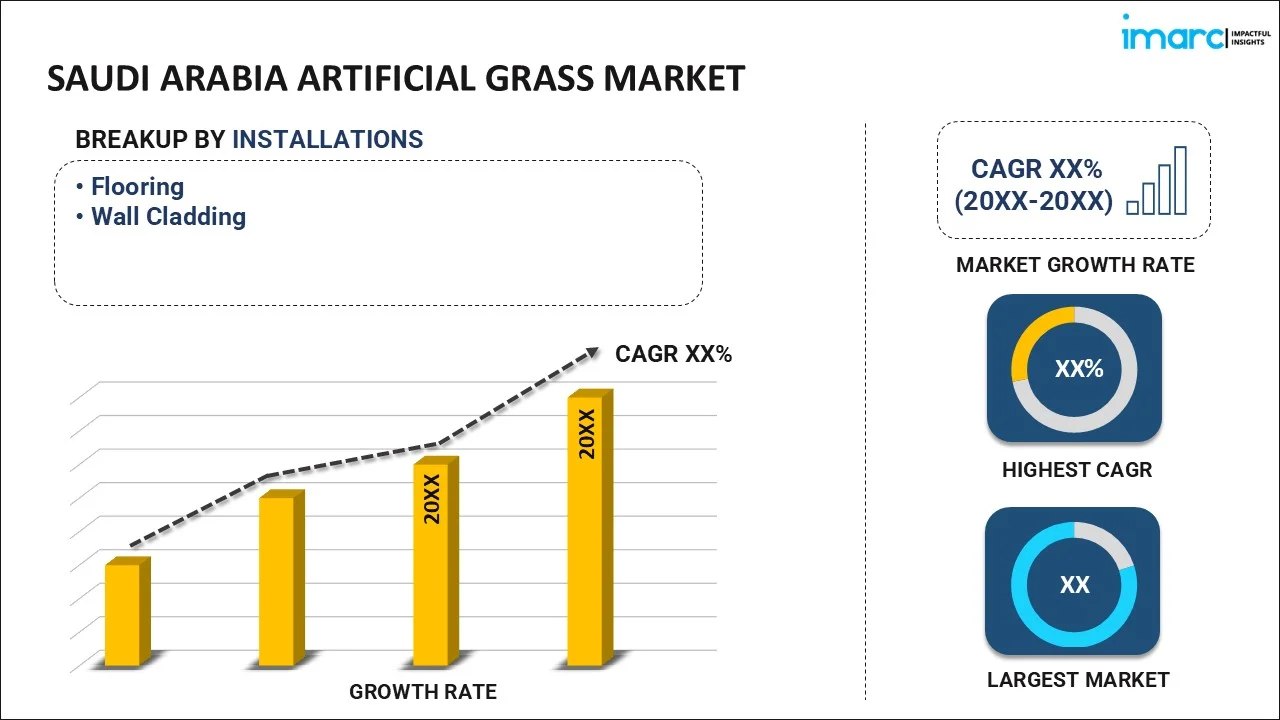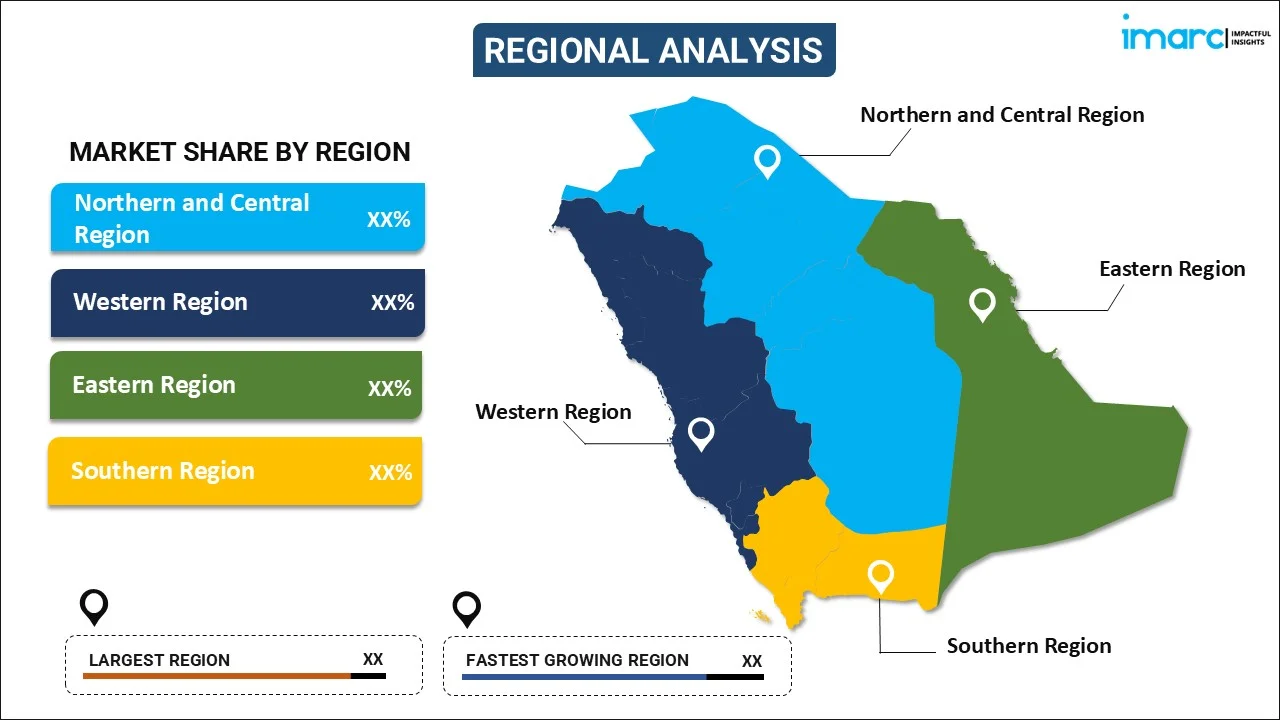
Saudi Arabia Artificial Grass Market Size, Share, Trends and Forecast by Installation, Material, Vertical, Usage and Region, 2025-2033
Saudi Arabia Artificial Grass Market Overview:
The Saudi Arabia artificial grass market size reached USD 54.57 Million in 2024. Looking forward, IMARC Group expects the market to reach USD 107.07 Million by 2033, exhibiting a growth rate (CAGR) of 7.78% during 2025-2033. The market is propelled by the growing construction and landscaping projects such as NEOM and the Red Sea project, rising implementation of water conservation and sustainability initiatives, and increasing preference for low-maintenance solutions in urban planning to reduce water consumption and enhance green spaces.
|
Report Attribute
|
Key Statistics
|
|---|---|
|
Base Year
|
2024
|
|
Forecast Years
|
2025-2033
|
|
Historical Years
|
2019-2024
|
| Market Size in 2024 | USD 54.57 Million |
| Market Forecast in 2033 | USD 107.07 Million |
| Market Growth Rate (2025-2033) | 7.78% |
Saudi Arabia Artificial Grass Market Trends:
Growing Construction and Landscaping Projects
The rapid expansion of construction and infrastructure projects in Saudi Arabia is driving the demand for artificial grass. Among them are several large-budget construction projects in the country, including NEOM and the Red Sea project, in wherein the government is highly investing. According to the International Trade Administration, this kind of high-value investment is to alter the regional outlook, for example, by changing NEOM to become a futuristic megacity valued at $500 Billion and making the Red Sea Project a luxury tourism destination along the Red Sea Coast. Artificial grass is favored as it is inexpensive, yet quick and easy to maintain with a lush appearance in arid climates where water conservation is very crucial. Active advocacy for modern urban landscapes and recreational spaces that do not depend too much on water has positioned artificial grass as a need to be included in many public and private projects.
Water Conservation and Sustainability Initiatives
As per the International Trade Administration, Saudi Arabia's economy has expanded rapidly over the past nine decades since the discovery of oil. From 35 Million today, the population is forecasted to increase to 40.1 Million by 2030. Such growth, along with limited natural water resources, has heightened the need for sustainable water management solutions. In alignment with Vision 2030 goals, Saudi Arabia is also prioritizing water conservation across various sectors, including urban development. One notable initiative is the adoption of artificial grass in landscaping. Unlike natural grass, which requires significant irrigation, artificial grass eliminates the need for water, offering a sustainable alternative for residential lawns, commercial spaces, and public parks. This shift supports the country’s water-saving objectives and enables urban developers to align with government policies, fostering eco-friendly urbanization. By integrating artificial grass into urban planning, Saudi Arabia can significantly reduce water consumption while enhancing green spaces, creating a win-win situation for both communities and the environment.
Rising Preference for Low-Maintenance Solutions
The growing inclination toward low-maintenance and cost-effective solutions has led to a surge in demand for artificial grass in Saudi Arabia. Maintenance of natural grass is labor-intensive and costly, especially when maintaining it in a desert climate that requires frequent watering and care. Artificial grass offers a visually appealing, durable, and low-maintenance alternative, thus gaining more popularity among both homeowners and property managers. Advances in artificial turf technology continue to make it more realistic and comfortable and therefore increase the adoption rate of residential lawns, playgrounds, and sports fields in the market. This shift is driven by the benefits of reduced upkeep costs, durability, and year-round greenery without the hassle.
Saudi Arabia Artificial Grass Market Segmentation:
IMARC Group provides an analysis of the key trends in each segment of the market, along with forecasts at the regional level for 2025-2033. Our report has categorized the market based on installation, material, vertical, usage and region.
Installation Insights:

- Flooring
- Wall Cladding
The report has provided a detailed breakup and analysis of the market based on the installation. This includes flooring, and wall cladding.
Material Insights:
- Polyethylene
- Polypropylene
- Nylon
The report has provided a detailed breakup and analysis of the market based on the material. This includes polyethylene, polypropylene, and nylon.
Vertical Insights:
- Residential
- Commercial
- Sports Facilities
A detailed breakup and analysis of the market based on the vertical have also been provided in the report. This includes residential, commercial, and sports facilities.
Usage Insights:
- Outdoor
- Indoor
The report has provided a detailed breakup and analysis of the market based on the usage. This includes outdoor and indoor.
Regional Insights:

- Northern and Central Region
- Western Region
- Eastern Region
- Southern Region
The report has also provided a comprehensive analysis of all the major regional markets, which include northern and central region, western region, eastern region, and southern region.
Competitive Landscape:
The market research report has also provided a comprehensive analysis of the competitive landscape. Competitive analysis such as market structure, key player positioning, top winning strategies, competitive dashboard, and company evaluation quadrant has been covered in the report. Also, detailed profiles of all major companies have been provided.
Saudi Arabia Artificial Grass Market News:
- In July 2024, SIS Pitches, creators of the Kingdom Arena pitch that broke the World Record, is to expand in Saudi Arabia and the wider Middle East. The company, which produces hybrid, synthetic, and natural pitches for every sport, has so far invested over 1.3M SAR ($370,000) in the region and opened three maintenance depots across the country. Additionally, two new turf farms have been inaugurated in Saudi Arabia and Turkey.
Saudi Arabia Artificial Grass Market Report Coverage:
| Report Features | Details |
|---|---|
| Base Year of the Analysis | 2024 |
| Historical Period | 2019-2024 |
| Forecast Period | 2025-2033 |
| Units | Million USD |
| Scope of the Report |
Exploration of Historical Trends and Market Outlook, Industry Catalysts and Challenges, Segment-Wise Historical and Future Market Assessment:
|
| Installations Covered | Flooring, Wall Cladding |
| Materials Covered | Polyethylene, Polypropylene, Nylon |
| Verticals Covered | Residential, Commercial, Sports Facilities |
| Usages Covered | Outdoor, Indoor |
| Regions Covered | Northern and Central Region, Western Region, Eastern Region, and Southern Region |
| Customization Scope | 10% Free Customization |
| Post-Sale Analyst Support | 10-12 Weeks |
| Delivery Format | PDF and Excel through Email (We can also provide the editable version of the report in PPT/Word format on special request) |
Key Questions Answered in This Report:
- How has the Saudi Arabia artificial grass market performed so far and how will it perform in the coming years?
- What is the breakup of the Saudi Arabia artificial grass market on the basis of installation?
- What is the breakup of the Saudi Arabia artificial grass market on the basis of material?
- What is the breakup of the Saudi Arabia artificial grass market on the basis of vertical?
- What is the breakup of the Saudi Arabia artificial grass market on the basis of usage?
- What is the breakup of the Saudi Arabia artificial grass market on the basis of region?
- What are the various stages in the value chain of the Saudi Arabia artificial grass market?
- What are the key driving factors and challenges in the Saudi Arabia artificial grass market?
- What is the structure of the Saudi Arabia artificial grass market and who are the key players?
- What is the degree of competition in the Saudi Arabia artificial grass market?
Key Benefits for Stakeholders:
- IMARC’s industry report offers a comprehensive quantitative analysis of various market segments, historical and current market trends, market forecasts, and dynamics of the Saudi Arabia artificial grass market from 2019-2033.
- The research report provides the latest information on the market drivers, challenges, and opportunities in the Saudi Arabia artificial grass market.
- Porter's five forces analysis assist stakeholders in assessing the impact of new entrants, competitive rivalry, supplier power, buyer power, and the threat of substitution. It helps stakeholders to analyze the level of competition within the Saudi Arabia artificial grass industry and its attractiveness.
- Competitive landscape allows stakeholders to understand their competitive environment and provides an insight into the current positions of key players in the market.
Need more help?
- Speak to our experienced analysts for insights on the current market scenarios.
- Include additional segments and countries to customize the report as per your requirement.
- Gain an unparalleled competitive advantage in your domain by understanding how to utilize the report and positively impacting your operations and revenue.
- For further assistance, please connect with our analysts.
 Inquire Before Buying
Inquire Before Buying
 Speak to an Analyst
Speak to an Analyst
 Request Brochure
Request Brochure
 Request Customization
Request Customization




.webp)




.webp)












